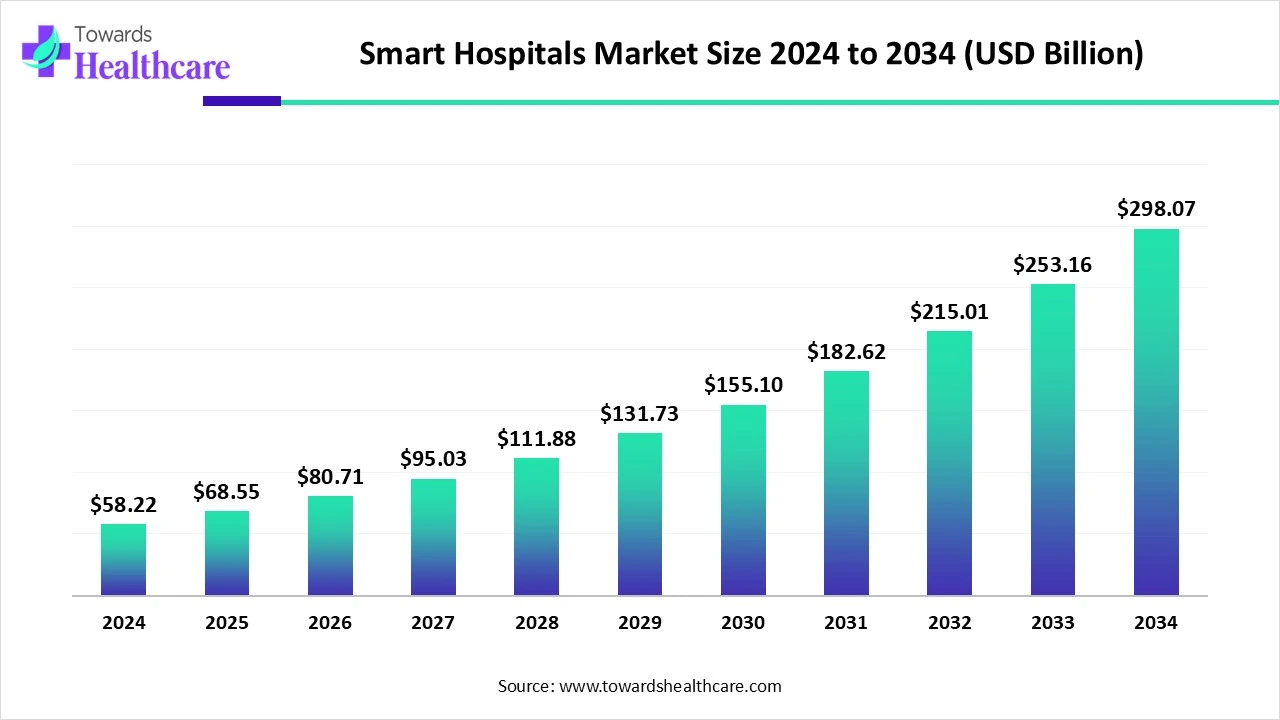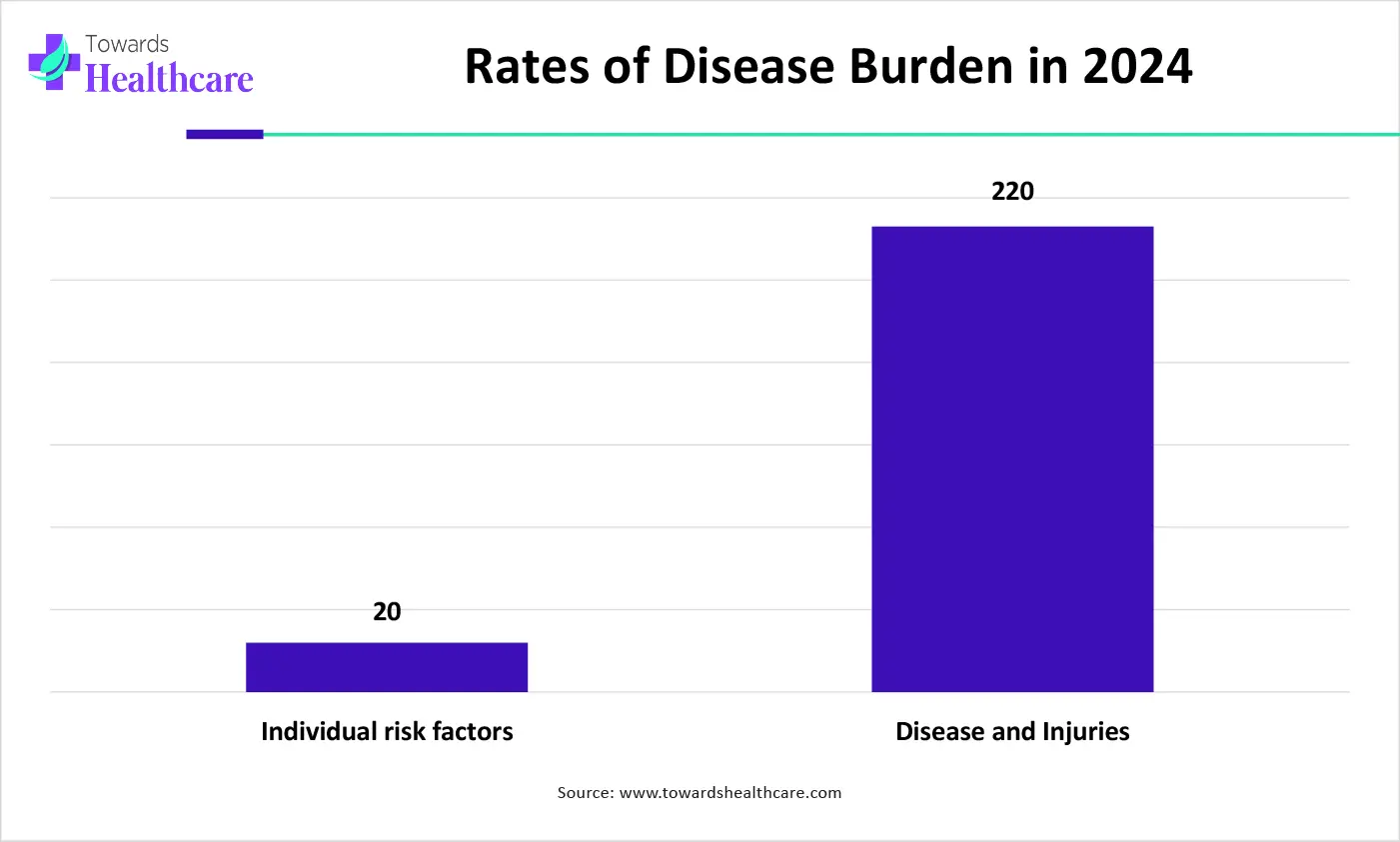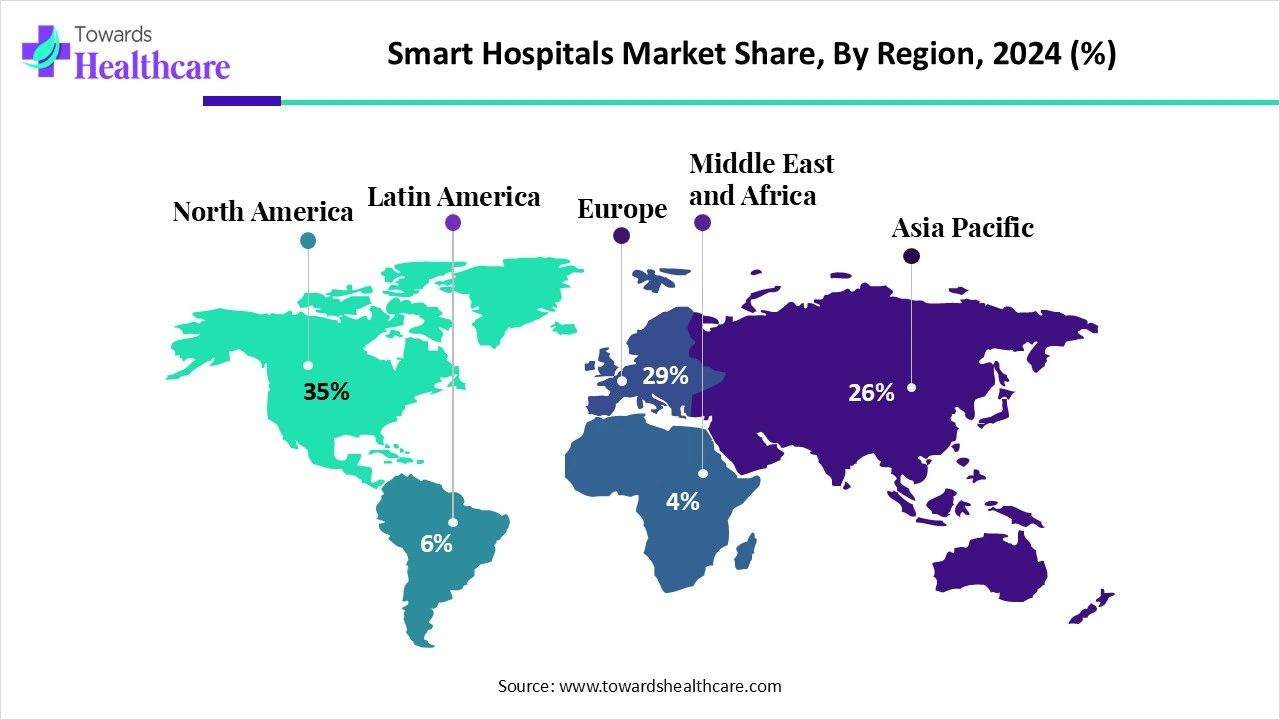October 2025

The global smart hospitals market size is calculated at USD 58.22 in 2024, grew to USD 68.55 billion in 2025, and is projected to reach around USD 298.07 billion by 2034. The market is expanding at a CAGR of 17.74% between 2025 and 2034.

| Metric | Details |
| Market Size in 2025 | USD 68.55 Billion |
| Projected Market Size in 2034 | USD 298.07 Billion |
| CAGR (2025 - 2034) | 17.74% |
| Leading Region | North America share by 35% |
| Market Segmentation | By Component, By Product, By Connectivity, By Region |
| Top Key Players | Philips, Medtronic, Microsoft, Honeywell Life Care Solutions, Allscripts, Qualcomm Life, GE Healthcare, Stanley Healthcare, SAP, Cerner Corporation |
To improve the medical and economic performance of hospitals or institutions the redesigning clinical processes, management systems, and infrastructure with the use of the latest technologies is known as a smart hospital. With these advanced technologies, the services and information provided to the patient are enhanced. Furthermore, the smart infrastructure also helps in improving patient care. The smart infrastructure may consist of equipment, buildings, technical and material resources, engineering networks, and means of transportation, used to carry out diagnosis and treatment.
Artificial intelligence and information technology play a vital role in smart hospitals. The patient care is improved along with the productivity, and the expenses are minimized with the help of AI, robotics, IoT, and big data analytics. Furthermore, by using EHRs with AI, the data about mortality, length of stay, readmission rates, as well as complications of diseases, are identified. Similarly, the medical data about the patients is also protected, which enhances patient safety and satisfaction. Thus, the smart hospitals provide positive patient outcomes.
Increasing Demand for Healthcare Services
Growing diseases within the population are increasing the demand for new and effective diagnostic as well as treatment opportunities. At the same time, to enhance the efficiency of the hospital staff, the demand for technological advancements is rising. Similarly, to reduce the time during data transfer, effective policies, reimbursement, etc., also require advanced technologies. Thus, all these factors are responsible for driving the demand for healthcare services along with the adoption of technological advancements within the hospital, contributing to the digital transformation. Thus, it results in the smart hospital market growth.

The graph represents the total rates of disease burden in 2024 as per the Australian Burden of Disease Study (ABDS). It indicates that there is a continuous rise in disease burdens. Hence, it increases the demand for advanced healthcare services for its effective management, which in turn, increases the demand for smart hospitals. Thus, this in turn will ultimately promote the market growth. (Source - Australian Institute of Health and Welfare)
High Prices
The implementation of various advanced technologies in hospitals increases the costs associated with it. Furthermore, the systems, platforms, as well as involvement of robotics also add to the cost. The regular updates are required by the technologies for enhancing their performance as well as protecting the data from any cyberattacks. Moreover, the training of staff also contributes to the increased cost.
Increasing use of Electronic Health Records
Electronic Health Record (EHR) helps in storing the data of the patient. Furthermore, it can also be transferred effectively to any platform where the data could be used by the clinician to make the appropriate decision about the patient's condition. It also monitors the health of the patients and helps to plan personalized treatment approaches. This, in turn, enhances patient satisfaction, adherence, as well as outcomes. Thus, this promotes the smart hospitals market growth.
For instance,
By component type, the software & systems segment dominated the market in 2024. This segment dominated because the software & systems helped in the collection as well as transfer of the patient records. At the same time, it helped in effective diagnosis and monitoring options, which helped the patient care. Thus, it enhanced the smart hospitals market growth.
By component type, the services segment is estimated to grow significantly at a notable CAGR during the forecast period. The services component is helping the hospital staff during the software updates, data analysis, troubleshooting, etc. This increases its demand in smart hospitals.
By product type, the telemedicine segment dominated the market in 2024. The segmental growth is attributed to the rising geriatric population, growing demand for home healthcare, and technological advancements. The telemedicine helped in providing hospital services in rural areas with limited hospital facilities. It also helped in chronic disease monitoring. This increased the market growth.
By product type, the electronic health records segment is anticipated to grow significantly during the forecast period. The electronic health records are being used in the effective accumulation and storage of medical data. Furthermore, it also helps in providing decisions and treatment plans to the patient.
By connectivity type, the wireless segment dominated the global smart hospitals market in 2024 and is predicted to be the fastest growing during the forecast period. The segment dominated due to advancements in wireless technology and favorable healthcare infrastructure. The wireless connectivity simplifies the data collection and transfer irrespective of the location. Moreover, it also enhances communication with the patients from different locations, enhancing their satisfaction.

North America dominated the smart hospitals market share by 35% in 2024. North America consisted of a well-developed healthcare sector with the presence of technological advancements, as well as skilled personnel. This enhanced the adoption of various advanced health services. Thus, this contributed to the market growth.
The healthcare sector in the U.S. is advanced due to the utilization of various new services, making a digital transformation in hospitals. This is also supported by the regulatory guidelines, making it safer to use.
Various hospitals in Canada are adopting different technologies that help hospitals in streamlining their work. This, in turn, increases the number of smart hospitals. Furthermore, they also enhance patient outcomes.
Europe is expected to grow significantly in the smart hospitals market during the forecast period. The healthcare sector in Europe is adapting to various technological advancements. This, in turn, is enhancing the different departments in the hospitals, which in turn, helps in improving the smart hospital development.
The rising demand for the use of new solutions for diagnosis, monitoring, as well as treatment is increasing the utilization of new technologies in hospitals. This, in turn, drives the hospital's digital transformation. Moreover, the strong regulation also contributes to the same.
The hospital in the UK area is adopting new AI-based or other technological systems that help in the development of new smart hospitals. Furthermore, this also enhances patient care and outcomes. Moreover, it also leads to rising collaboration for technological advancements.
Asia Pacific is estimated to host the lucrative, growing smart hospitals market during the forecast period. Asia Pacific is experiencing rapid growth in the healthcare systems. Furthermore, new technologies, diagnostic as well as treatment options, are being developed as well as utilized. This is further supported by the government, which promotes the market.
China is adopting various new technologies, which help in the development of hospital services, which in turn enhance the patient experience. At the same time, to improve the safety of these solutions, guidelines are also implemented by the government as well as regulatory bodies.
India is facing a rapid expansion in the healthcare sector. Furthermore, digital transformation is also enhancing this growth, which contributes to the smart hospital developments. To make the services affordable government is also providing its support.
Latin America is expected to grow at a notable CAGR in the smart hospitals market in the foreseeable future. The increasing adoption of advanced technologies in healthcare organizations and favorable regulatory policies. The growing demand for advanced and personalized care for patients also potentiates market growth. The Pan American Health Organization (PAHO) launched the “Smart Hospitals Initiative” to improve hospitals’ resilience, strengthen structural and operational aspects, and provide green technologies. (Source: PAHO) The increasing investments by private and government organizations promote the market.
Smart hospitals are increasingly being developed in Mexico to aid patient-centricity, integration, and good financial planning. There are around 4,000 hospitals in Mexico, of which 64% are private and 36% are public. The Mexican government recently announced an investment of 25 billion pesos (US$ 1.23 billion) to build seven new hospitals in seven states, benefitting 3 million patients. (Source: BN Americas)
Brazil has the largest healthcare market in Latin America. Brazil spends around 9.47% of its GDP on healthcare, representing US$161 billion. There are more than 7,200 hospitals in Brazil, of which 62% are private and 38% are public. A member of the Inter-American Development Bank Group, IDB Invest, launched “The Smart Hospital” project to modernize and provide maintenance and operation services for the Souza Aguiar Hospital Complex, Rio De Janeiro. (Source: IDB Invest)

By Component
By Product
By Connectivity
By Region
Market insights predict, the oncology biosimilars industry is expected to grow from USD 6.7 billion in 2024 ...
Research studies indicate that the in vivo CAR-T platform market is experiencing significant growth, drive...
October 2025
November 2025
November 2025
November 2025